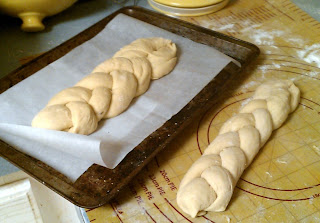To download a copy of the recipe for Challah Bread Three
Ways, click HERE.
 You no doubt know by now that challah bread has reached far beyond its original Hebrew
cultural beginnings and is widely-enjoyed in the mainstream. World over, people
who don’t know the difference between nachas and nachos recognize this sweet
egg bread as something that is both delicious in its own right, and that one of
the best breads anywhere for making French Toast.
You no doubt know by now that challah bread has reached far beyond its original Hebrew
cultural beginnings and is widely-enjoyed in the mainstream. World over, people
who don’t know the difference between nachas and nachos recognize this sweet
egg bread as something that is both delicious in its own right, and that one of
the best breads anywhere for making French Toast.
As the title suggests, this week’s recipe uses the challah
dough in three ways:
- traditional braided loaf;
- in a loaf pan for use in making French Toast;
- with raisins and dried apricots, sweetened with extra honey, and formed into a round shape, as it is traditionally served for the Jewish New Year. (Imagine a bread pudding made with that!)
You can use the recipe to make two larger loaves or three
smaller loaves. I chose to make the three smaller loaves to show each of the
three ways listed above. (For that reason, in this batch shown in the photographs
below, I added only 1/3 of the raisins, apricots and extra honey to 1/3 of the
dough batch since, for demonstration purposes, I was only making one of the
challahs round.)
Some Cook’s Notes before we begin:
- If you’ve never baked bread before, you might be tempted to let yourself be put off by what you’ve heard about how long it takes. I hope to convince you otherwise. While it’s true that there are several hours between the time you break out the flour and the time you take the fresh-baked loaves out of the oven, almost all of that is inactive time: the dough is doing the work while you’re going about your day.
- Although honey is recommended, sugar may be used instead.
- If you’ve never braided, it’s not hard to do. You can find many explanations on line. One excellent source of braiding methods can be found at www.virtue.to/articles/braiding.html. (It’s a hair-braiding article, but the method is applicable to challah also.)
As noted, this recipe makes 2 larger loaves or 3 smaller loaves.
We’ll start by preparing the yeast mixture:
To make the dough:
In a large bowl (such as the bowl of a stand mixer), combine ½ cup of olive oil, ½ cup of honey (use ¾ cup if you’re making the round New Year challah), and 1 Tbsp salt. Add 1-1/2 cups of warm (110 degree) water to the bowl and stir until all is dissolved.
Add the yeast mixture to the large bowl, along with 3 cups of all-purpose flour and three egg-substitute eggs. (If you’re making the round New Year challah, add ¼ cup of raisins and ¼ cup of chopped, dried apricots also.)
Add 4 additional cups of flour, 1 cup at a time, mixing thoroughly after each addition. (Be mindful of mixer speed so that flour does not fly out of the bowl!)
Turn the dough out onto a floured surface and knead for 5 minutes. (If using a stand mixer, you can knead the dough using the dough hook.)
Place the dough into an oiled bowl, cover with oiled plastic wrap, and set aside to rise for two hours.
Divide the dough into two or three equal portions, depending on whether you’re making two larger loaves or three smaller loaves.
Here’s where we form the different loaf types. If you’re
making a traditional braided challah:
Cut the 2/3 portion into three equal parts and roll each into a snake.
Braid the three larger snakes.
Cut the 1/3 portion into three equal parts and roll each into a snake the same length as the larger snakes. Braid the three smaller snakes.
Place the smaller braid on top of the larger braid, and place on a baking sheet covered with parchment or a silicon sheet.
Making the challah as a loaf for making French
Toast is similar to the above, except you're using the entire portion to make and braid only one set of snakes:
If you’re making the round, sweetened challah:
Repeat the above for the remaining dough portions.
Next, we'll “bench proof” the loaves:
Regardless of which shape(s) you have chosen to make, cover the formed loaves with plastic wrap and set aside to proof for one hour.
To bake the loaves:
Preheat the oven to to 375 degrees.Brush the top of each dough gently with a sweet egg wash made by combining one egg-substitute egg, 1 Tbsp water, and ½ Tbsp honey. (If using poppy seeds or sesame seeds, sprinkle them on now.) Bake till well browned, about 35 minutes. Be careful not to let the loaves burn.
Let the loaves cool on racks.To download a copy of the recipe for Challah Bread Three Ways, click HERE.
So now you can enjoy fresh-baked challah bread, any time you
like!
Hope to see you next week for another delicious home-cooked
recipe! Till then, stay well, keep it about the food, and always remember to
kiss the cook. ;-)














Though, as you know, I don't eat much bread these days, challah has always been one of my favorites (along with sourdough). And I've often thought that the smell of fresh bread is almost as good as the taste!
ReplyDeleteThanks, Sandy. Bread symbolizes so much, it always feels like there is something fulfilling, even sacred, about baking it. We had a special breakfast yesterday of French Toast made with the loaf challah and topped with an apple compote topping. For those occasions where you do choose to eat bread, definitely recommended!
ReplyDelete